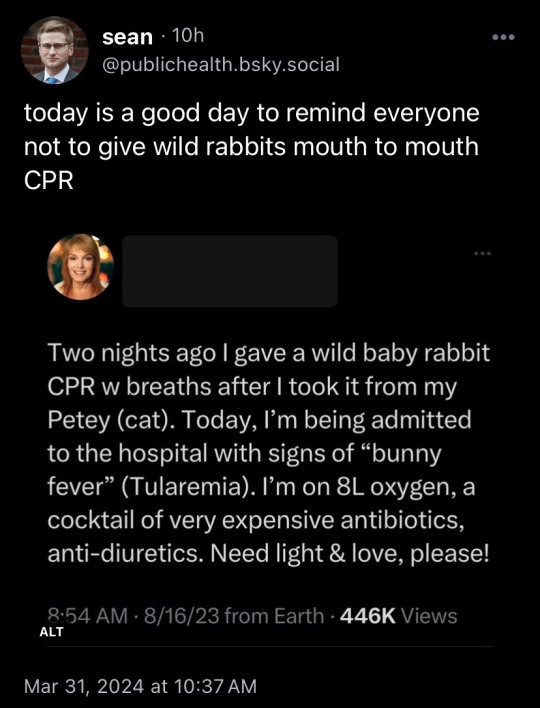#zoonotic
Text
Zoonotic diseases encompass various types, including:
Bacterial infections: Examples include anthrax, brucellosis, and leptospirosis.
Viral infections: Such as rabies, Ebola virus disease, and influenza (bird flu, swine flu).
Parasitic infections: Like toxoplasmosis, malaria (transmitted by mosquitoes), and cryptosporidiosis.
Fungal infections: Histoplasmosis and ringworm are examples of fungal zoonoses.
Prion diseases: Such as variant Creutzfeldt-Jakob disease (vCJD), transmitted through consumption of contaminated meat.
These are just a few examples, as there are numerous zoonotic diseases with varying transmission routes and effects on human health.
Preventing the spread of zoonotic diseases involves several strategies:
Good hygiene practices: Regular handwashing with soap and water, especially after handling animals or their waste, can reduce the risk of transmission.
Vaccination: Vaccinating animals against zoonotic diseases like rabies and brucellosis can prevent transmission to humans.
Vector control: Controlling vectors such as mosquitoes and ticks through measures like insect repellents and environmental management can reduce the spread of diseases like malaria and Lyme disease.
Safe food handling: Cooking meat thoroughly and avoiding consumption of raw or undercooked meat, eggs, and unpasteurized dairy products can prevent foodborne zoonotic infections.
Animal control: Implementing measures to control the population of stray animals and preventing contact between domestic animals and wildlife can reduce the risk of transmission.
Personal protective equipment (PPE): Wearing appropriate PPE, such as gloves and masks, when handling animals or working in environments where zoonotic diseases are prevalent can reduce the risk of infection.
Surveillance and monitoring: Regular surveillance of both animal and human populations for zoonotic diseases can help identify outbreaks early and implement control measures effectively.
Education and awareness: Educating communities about the risks of zoonotic diseases and promoting preventive measures can empower individuals to protect themselves and their families.
By implementing these preventive measures, we can reduce the transmission of zoonotic diseases and mitigate their impact on public health.
Overall, zoonotic diseases pose significant risks to both human and animal health, as well as to global public health and economic stability. Preventive measures and surveillance efforts are crucial for mitigating these risks and reducing the impact of zoonotic diseases.
Get the best treatments for various diseases and full body health checkup at the best hospitals in India.
#full body#health#healthcheckup#regular health checkup#surgery#zoonotic#bacterial infections#viral infections#fungal infection
0 notes
Text
[ So Now There Is A Disease X ]
#wauln#fc 24#who#disease x#pathogens#outbreaks#pandemics#virus#disease#zoonotic#bioterrorism#biological#agents
0 notes
Text
Parasitic Worm 3 inch long Discovered in Woman’s Brain
Read more:👇
#parasiticworm#brain#womenbrain#parasite#zoonotic#australianwomen#todayonglobe#tognews#tog#news#dailynews#dailynewsupdate#breakingnews#latestnews#trendingnews
0 notes
Note
music asks 1-5 :))
music asks
1) A song you like with a color in the title
red wine supernova - chappell roan
2) A song you like with a number in the title
1984 - jacob maul
3) A song that reminds you of summertime
dial drunk - noah kahn, post malone
4) A song that reminds you of someone you would rather forget about
sorry to your next ex - haiden
5) A song that needs to be played LOUD
i wanna get better - the bleachers
0 notes
Text
Zoonoses can be described as infections that people can get from animals.
#zoonoses#zoonosis#animals#infections#humans#infection#zoonotic#species#drugcarts#onlinepharmacy#pharmacy#medicine#healthcare#doctors
0 notes
Text
Hardcore lesbo bdsm act with steaming spanking act
Freaky Natasha Gettin Dat Sweet Tight Asshole Ate
Gay pornyoung boys sperm and hard extreme movies leading all the way
HITZEFREI German MILF Caroline Ardolino gets a big dick
Jasmine Grey In Extra Small Spitroasting
mahlon holt us army
Rikki Rumor Lets BBC Bust A HUGE Nut In Her Slutty Mouth
Paladins Rise Of Furia
Cute teen japanese in face cum
Toyed And Fucked While Bound and Dominated in Asian BDSM
#Overpeck#contribution#doomfulness#spermatozoic#diener#piedforts#zoonotic#Ineducabilia#Mu'min#hexades#gonophoric#crazedly#defectum#multipurpose#perlucidus#squattered#universanimous#semisuspension#albumimeter#Adonijah
0 notes
Text
What Is Coccidia?
Coccidia are single-celled bloodsuckers called protozoa that infect the digestive system of pet cats. According to Hutchison, there are a number of different species of coccidia that influence felines, consisting of species of Isospora, Toxoplasma, Hammondia, Besnoitia, Cryptosporidium, as well as Sarcocystis.
Hutchison says the Isospora varieties (Isospora felis and Isospora revolta, likewise called Cystoisospora spp.) are without a doubt the most typical in felines. They’re likewise species-specific. This means, as an example, that dogs can not get infected with the two Isospora species that contaminate cats. And also fortunately, humans can not either. Nonetheless, Hutchison notes that some of the other coccidia species (like Toxoplasma gondii) are possibly zoonotic (which indicates they can be passed from animals to individuals).
0 notes
Text

Don’t give CPR to wild animals: a thing you wouldn’t think you’d have to tell people but apparently you do. 💀
820 notes
·
View notes
Photo

COVID-19 origins 'most likely zoonotic', but experts warns of the world's failure to reduce animal-to-human transmission for the next pandemic. #SARSCoV2 #coronavirus #COVID19 #Covid_19 #zoonotic #zoonoticdisease #pandemic #NextPandemic https://www.abc.net.au/news/2022-10-11/covid-19-transmission-human-animal-transmission/101519434 https://www.instagram.com/p/CjjittIrHf7/?igshid=NGJjMDIxMWI=
0 notes
Text
After Coronavirus, World Sees New Zoonotic Langya Henipavirus
After Coronavirus, World Sees New Zoonotic Langya Henipavirus
As the world slowly starts to recover from Coronavirus, a new zoonotic virus has now emerged from China’s two eastern provinces – Shandong and Henan provinces – with 35 infections identified so far. The new virus is named Langya Henipavirus or the LayV.
The newly discovered virus classified as biosafety level 4 (BSL4) pathogens can cause severe illness in animals and humans. Moreover, no…

View On WordPress
0 notes
Text
entomologyabby: Most insects are harmless! But there are a few you want to avoid, kissing bugs being one of them. Kissing bugs transmit Chagas disease. If treated early Chagas can be treated, if not Chagas can develop into a chronic infection. Many people are unfamiliar with what kissing bugs look like and I have received photos from time to time of people holding insects that can hurt them. Just be sure you know what you're handling when touching insects :)
#bugs#bugblr#insects#insect#entomology#bug#found elsewhere and uploaded by me#tiktok#chagas#kissing bugs#bug bites#zoonotic disease
682 notes
·
View notes
Note
Re the rabid skunk
I’m from a country town and while it’s not something I was taught in school, I was definitely taught by my parents and other adults in my life to report possibly rabid or sick animals. There is some worry about rabies and other diseases diseases rising in the wildlife population so the forest service try to stay on top of it.
It’s a little messed up that no one was taking your concern seriously. Even if it was just a weird skunk, rabies and other animal diseases are no joke and pose a threat to people and other animals.
Thank you! It's very...idk the word. Affirming? Good to know it's not just me that thinks it's like a responsibility to report potentially rabid animals, like it's just a thing you do
#ask away!#for anyone who missed my post about this yesterday#there was a skunk in my yard behaving very weird yesterday#out in bright daylight running full speed in a giant circle not being chased not looking for food#found a hiding place (under the shed in my yard) but did not stay there#came from the center of the neighborhood (away from forest not good for skunks)#ran towards forest then veered away back towards houses#so I tried to call to report the skunk to animal control in case it was rabies (or another potentially zoonotic disease)#and there just! is no animal control! where I live!#absolutely no governmental involvement AT ALL#and the private companies only handle stray pets not wildlife!#which is wild to me#what is government for if not to try to control rabies#like I understand that is not the central purpose of government but I do feel like it should at least be on the radar
38 notes
·
View notes